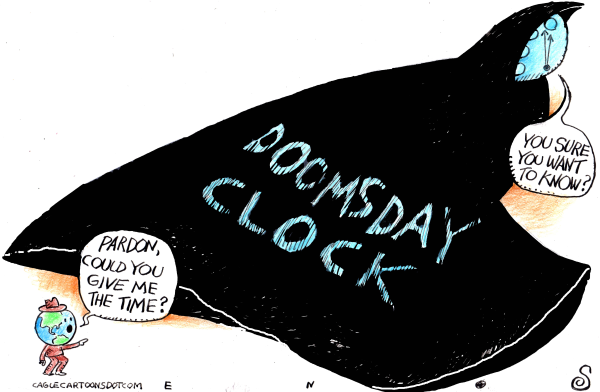Oppenheimer Never Learned to Love the Bomb
He Worried About the Future Use of Ever More Powerful Nuclear Weapons

The new Oppenheimer film is a genuine blockbuster hit. Its release is well-timed with the rising possibility of nuclear confrontation in the Russian-Ukrainian conflict. The film portrays the original production of the atomic bomb, but its key focus is on the decision-making in using it against Japan. Not surprisingly, the film is reviving popular discussion on this question.
Consider the competing issues around the decision to use the bomb that were covered by the film.
There was concern for loss of American lives if Japan’s surrender required an extended military invasion. This was countered with a question of whether Japan — contained by a blockade at the time — was already contemplating surrender.
Some questioned whether the devastation of the cities by atomic bombing would be sufficient to move the Japanese leadership to surrender. Japan had already experienced huge losses in the incendiary bombing of Tokyo in March 1945, but it continued to fight on.
Another consideration for using the bomb was to indirectly threaten the Soviet Union and limit its international influence as it entered the war against Japan. Ironically, some historians have argued that it was the Soviet entrance into the war, which commenced on August 9, 1945, that ultimately led Japan to surrender and not the atomic bombing.
Then there was argument about the original motivation and justification to create the bomb: to outrun Germany in obtaining one. This aim became moot when Germany surrendered before the bomb was produced.
The complex reasoning surrounding the use of the nuclear bomb against Japan makes for good drama. It’s doubtful, however, that American society will ever agree on whether that decision was the right one. Moreover, one can contest the relevance of that debate for the nuclear situation we are in today.
Contemporary circumstances call for a different set of questions about nuclear weapons. J. Robert Oppenheimer’s personal struggle depicted in the film points to those kinds of questions, but the film fails to address them in depth.
Oppenheimer believed the decision to drop the atomic bomb on Hiroshima and Nagasaki was necessary. He reiterated this position in a CBS news interview in 1965, less than two years before he died in February 1967. However, he opposed the development of the far more powerful hydrogen (thermonuclear) bomb, which he correctly envisioned would eventually replace atomic bombs like those used against Japan. Oppenheimer strongly voiced this opposition in a formal letter on August 17, 1945, to Henry Stimson, U.S. Secretary of War, just eight days after the Nagasaki bombing. Oppenheimer would argue for nuclear disarmament until he died.
The film has only a brief treatment of Oppenheimer’s concern over the proliferation of thermonuclear bombs. This is a missed opportunity to help awaken people in the U.S. and around the world to their real threat to annihilate life on our planet as we know it. Tragically, we seemed to have normalized the existence of these weapons of mass destruction.
Relatively few people knew about the secretive Manhattan Project before the bombing of Hiroshima and Nagasaki, including Harry Truman when he was Vice President! Today, the U.S. government freely, if not proudly, publicizes detailed facts about its nuclear arsenal.
The Department of Defense (DoD) posts a multimedia presentation on its website describing the power of its thermonuclear bombs and their delivery systems, comprising jet bombers, land-based intercontinental ballistic missiles (ICBMs), and Trident submarines. The website also discloses how these delivery systems are being modernized, which according to the Congressional Budget Office, is costing $1.2 trillion.
The DoD also publicizes its policy on using nuclear weapons. It can be found in its Nuclear Posture Review. The document makes clear that the U.S. is open to conducting a first nuclear strike against another nation, even in response to a non-nuclear attack.
What our government cannot publicize is any authentic intention of disarming itself of nuclear weapons as it promised to do more than 50 years ago, when it signed onto the Treaty on the Non-Proliferation of Nuclear Weapons, in 1968. The U.S. has led the world in the development of nuclear weapons since their creation. In effect, the world remains awash with them today.
Here then, are questions Americans should be struggling with, but aren’t:
How can we be so comfortable living under the greatest existential threat to life on our planet?
Where is our moral angst or outrage over maintaining such monstrous weapons, and spending such substantial resources to do so?
And, do we truly love our children and grandchildren, and do we want them to have full lives?
Residents on the Central Coast of California have a unique view of the U.S. nuclear weapons program. The U.S. Air Force Global Strike Command tests the nuclear ICBM system by firing unarmed missiles from Vanderberg Space Force Base at the Kwajalein Atoll in the Marshall Islands. Numerous folks in the Lompoc and Santa Maria Valleys can see the launches from their homes, and hear their windows rattle from the sound of their propulsion.
Readers are invited to join a scheduled protest at the main gate of Vandenberg, on Highway 1, at 1 p.m. this coming August 6, the 78th anniversary of the dropping of the atomic bomb on Hiroshima.



